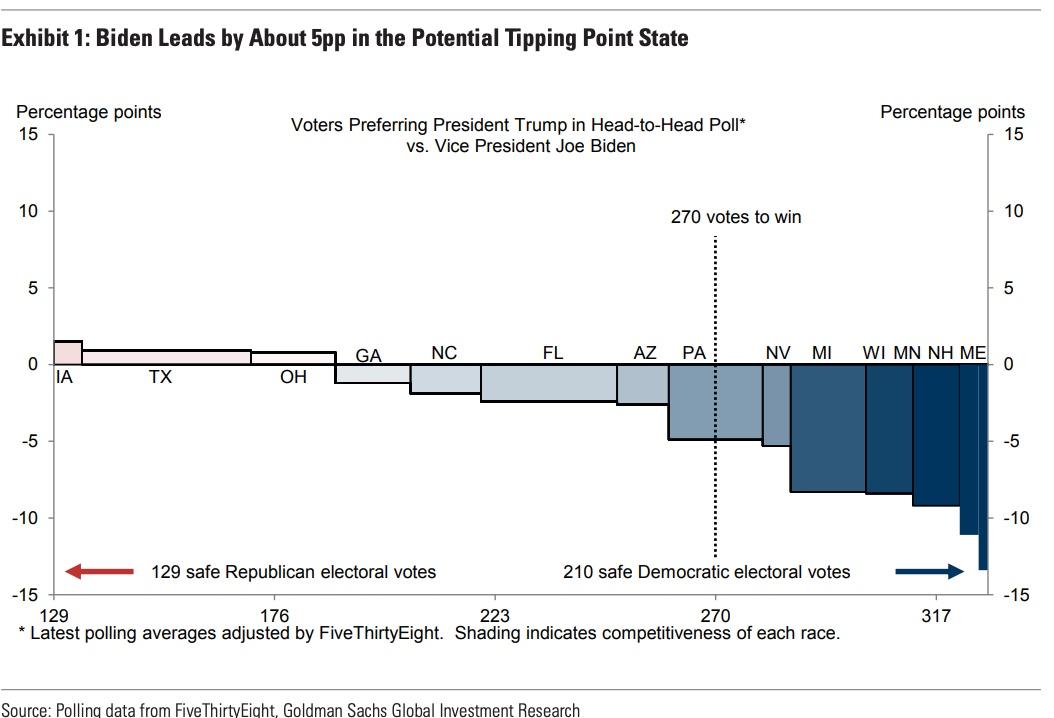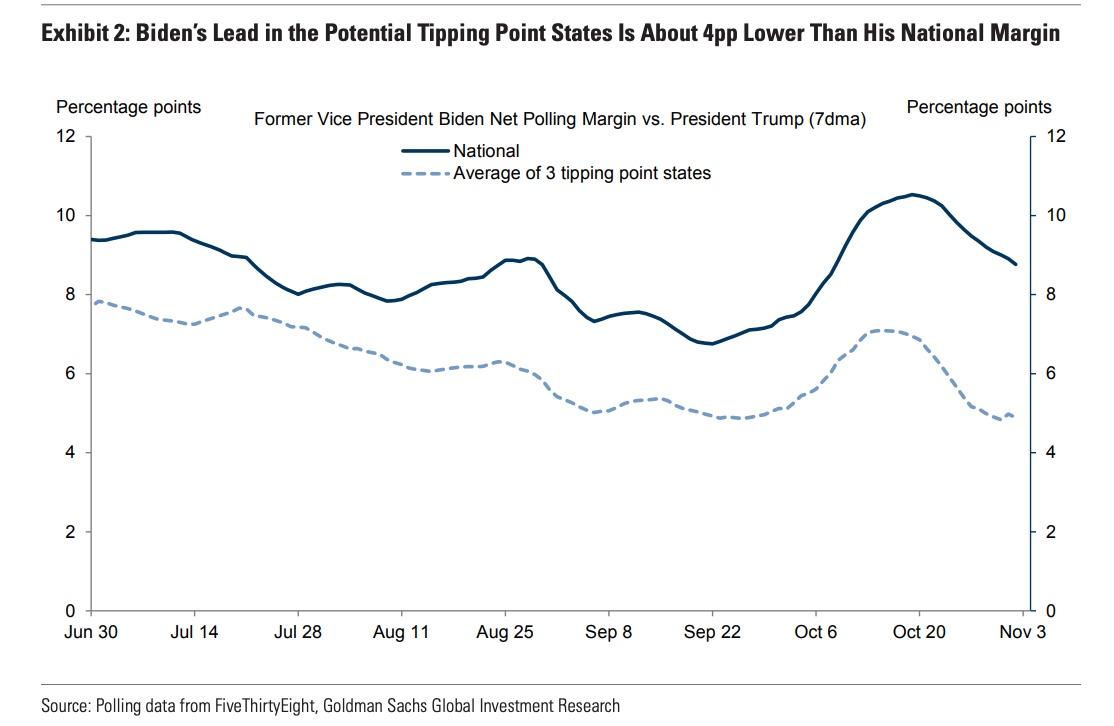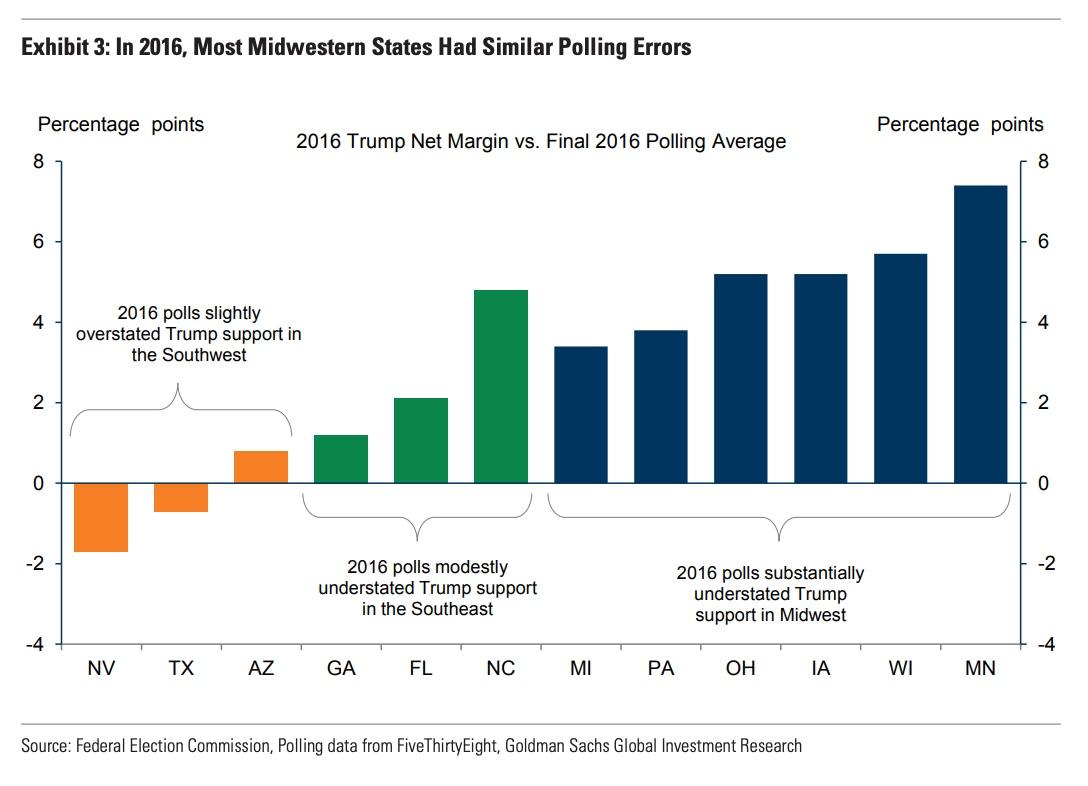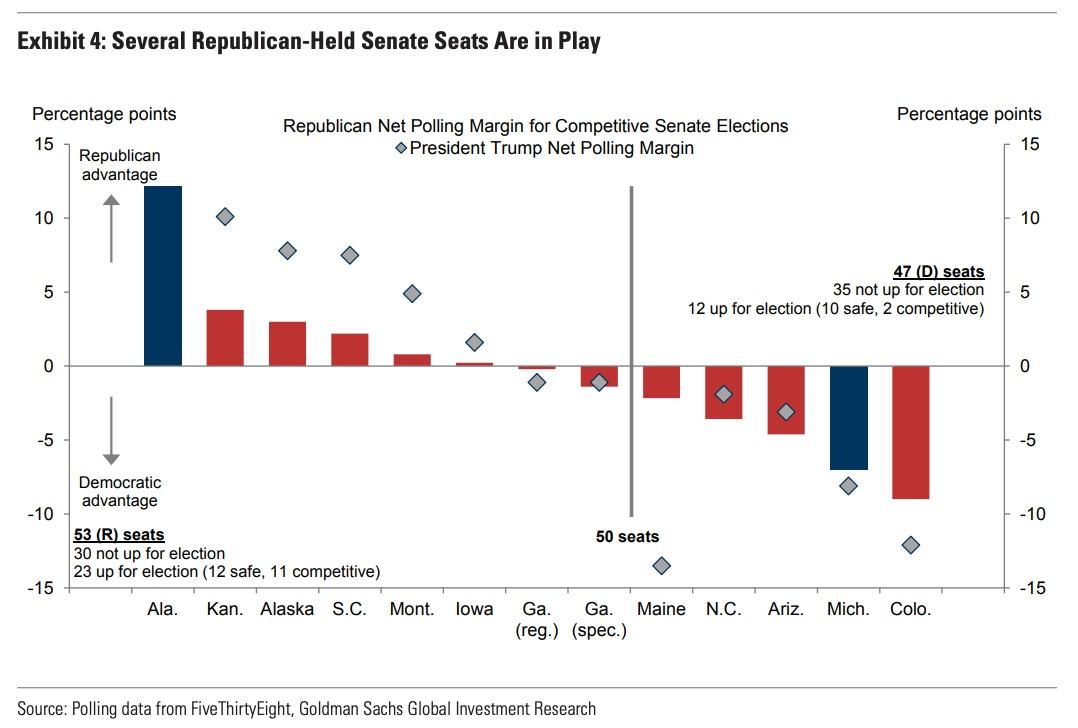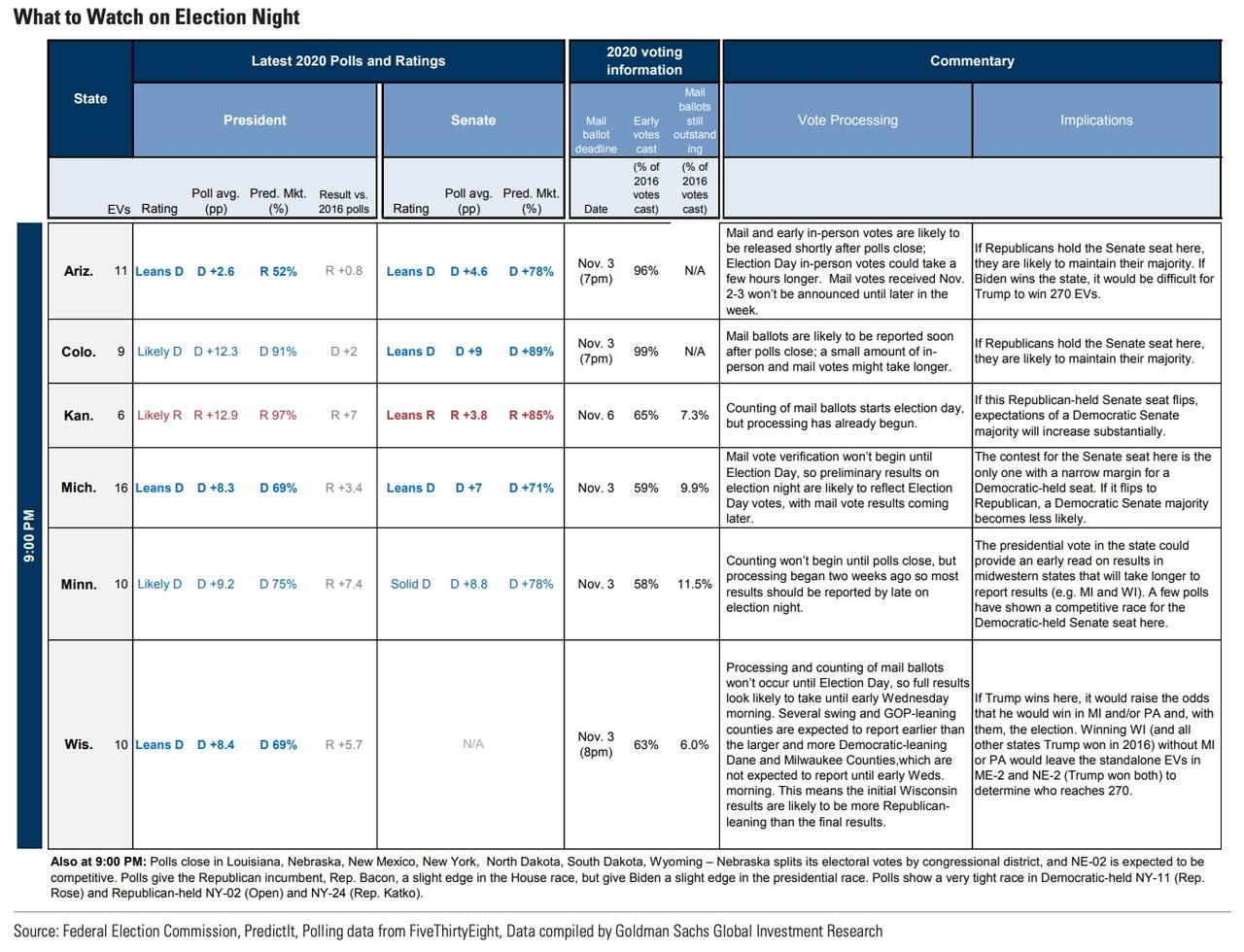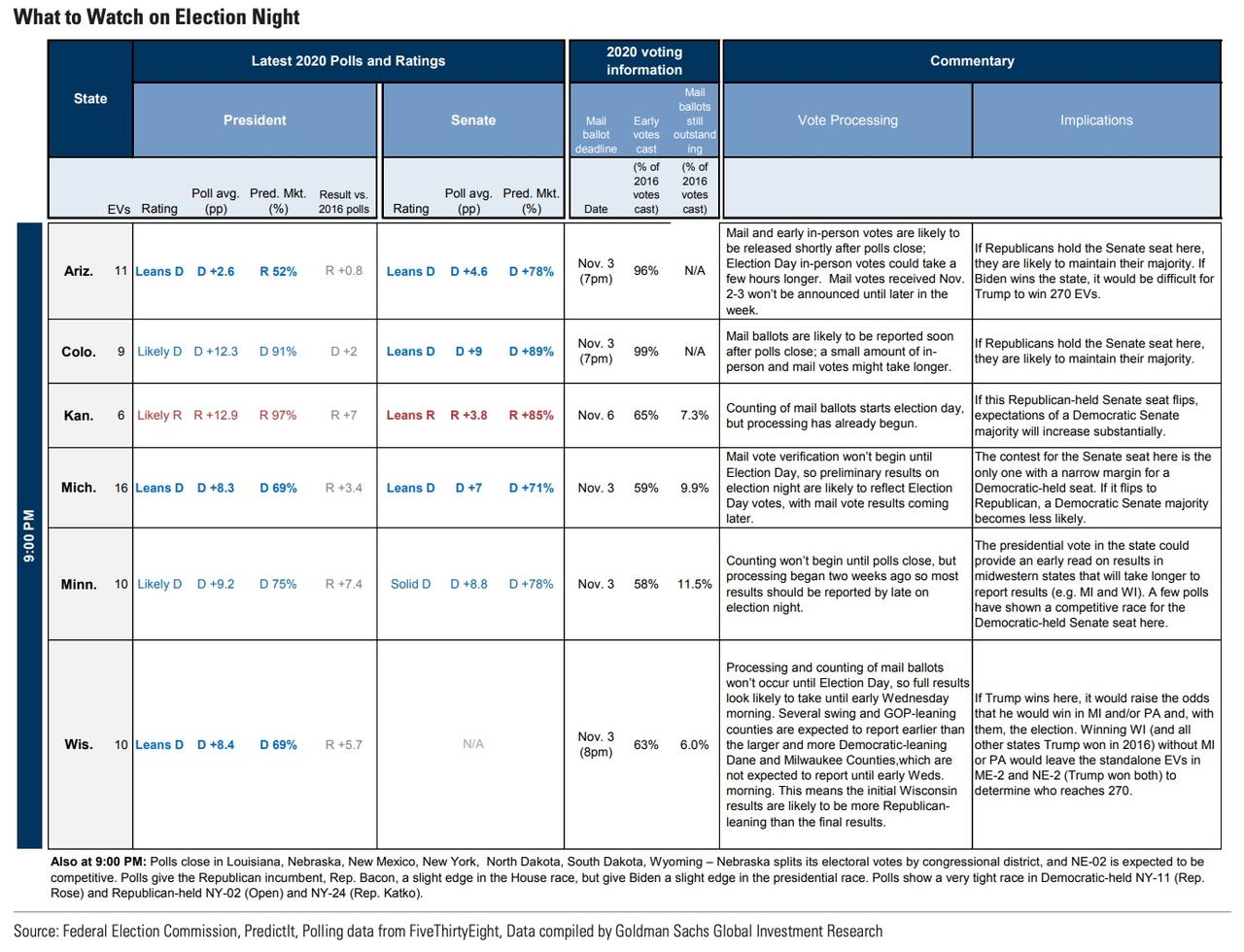These States Hold The Key To Who Will Win The Presidency, Goldman Says
Tyler Durden
Tue, 11/03/2020 – 13:10
Last night, we brought back our election night cheat sheet, a helpful guide to the potential pitfalls of one of the most hotly anticipated races in American history (for the Dems, the campaign to take back the White House effectively started on Nov. 9, 2016).
As investors and observers try to figure out how long until the results are known, a team of researchers at Goldman has produced a comprehensive note breaking down the importance of swing states by region, and offering a guide for what to watch for as the results are streaming in – starting with the fact that most of the ‘key states’ that will ultimately decide the race should be decided by midnight.
According to Goldman, polling heading into election day suggests the “tipping point” state will be Arizona, Pennsylvania or Nevada.
* * *
Most of the key states are likely to report meaningful results on election night. Among the presidential “battleground” states, Florida is likely to report the most quickly, with nearly all of its votes counted and reported on Tuesday night. Arizona, Colorado, Georgia, Iowa, North Carolina, and Ohio also look likely to report most of their results on election night (or the very early hours of Nov. 4). As shown in Exhibit 1, former Vice President Biden has been polling ahead in several of those states. While the national polling margin has tightened somewhat, the polling in the likely tipping point states (at the moment polls imply this would be Arizona, Pennsylvania, or Nevada) has remained fairly steady, showing a Biden lead of around 5pp.
However, Michigan and Pennsylvania, in particular, are likely to take longer to report results, meaning that unless one candidate amasses a large lead, the results in those states might not be clear for a few days, or longer. That said, preliminary results will provide some insight. More complete results in closely correlated states (e.g., Ohio, Minnesota) compared with final pre-election polls might also shed some light on which way Michigan and Pennsylvania might lean. Exhibit 3 shows that in 2016, most Midwestern states had similar polling errors compared with the final result, while polling in the Southwest and Southeast was more accurate, on average.
Early results could be misleading, in both directions. In several states, the first-reported results might favor one party, with results later in the night tightening the margin or changing the result. In Arizona, Florida, Kansas, North Carolina, Ohio, South Carolina, and Texas, mail and early in-person votes are likely to be released first, which will likely boost Democrats early in the night. Election Day votes released later are likely to lean more Republican. By contrast, in Alaska, Michigan, and Pennsylvania, the early results are more likely to reflect Election Day voting, which is likely to lean more Republican than the mail votes reported later.
States with mail ballot deadlines after Election Day could see a further shift. In the days following Election Day additional mail ballots look more likely to add to Democratic vote totals than Republican, though this will vary by state. This could be a factor in Alaska, Iowa, Kansas, Nevada, North Carolina, and Pennsylvania.
The margins in most of these states would need to be very close for these post-Election Day votes to be decisive. For example, in Pennsylvania, the remaining absentee ballots sent to voters but not yet returned amount to roughly 11% of the total 2016 vote; Democrats account for 6pp of this and Republicans for 4pp. Making the simple assumption that those voters vote for their party’s candidate, these ballots could boost the Democratic vote share by around 2pp, if all ballots are returned. The partisan gap in the remaining unreturned mail ballots is similar but slightly larger in North Carolina.
A Trump win could take longer to become apparent than a Biden win. The outcome in Arizona, Florida, Georgia, North Carolina and Ohio is likely to be reasonably clear on election night. In light of the correlations between states and the Electoral College math President Trump faces, if Biden wins any of those states—and especially if he wins more than one—markets are likely to believe he will win the election. By contrast, if Trump wins all of those states, as he did in 2016, it becomes much less likely that the result becomes clear quickly, as Pennsylvania could decide the result.
The Senate majority is likely to become clear on election night, but not the exact margin. We have argued that the Senate majority is at least as important as the presidential election for fiscal policy in 2021, and that a larger Senate majority (e.g., 53 or 54 seats) could lead to more substantial changes as well as potential elimination of the filibuster. As shown in Exhibit 4, the seats where Republican incumbents are trailing or are tied happen to be in states that should report results quickly: Colorado, Arizona, North Carolina, Maine, Iowa, Georgia and Montana. There are a few races that are likely to take longer, however. Michigan (Democratic incumbent) could take a few days to become clear, and Alaska (Republican incumbent) won’t count ballots until more than a week after the election. In Georgia, the results might become clear fairly quickly but at least one of the two Senate races is likely to go to a January 5 run-off, assuming none of the candidates clears 50% of the vote.
Ultimately, how quickly the media calls the results will depend on how close the result in a state is. Exhibit 5 plots the eventual 2016 vote margin in a state with how long it took the Associated Press to call the state after the polls closed that year. While some states took longer to call simply because they were slower to get results out, on average it took around 4 hours after poll closing to call races where the margin was more than 0.5pp and less than mid-single digits. A notable exception was Arizona, where Trump won by 3.55pp but which the AP took two days to call. Where the margin was smaller than 0.5pp, in New Hampshire and Michigan, it took the AP several days to call the race.
Here’s a roundup of what to watch for on in order of when the polls close:
Like the team at Goldman, analysts at SocGen also see a strong chance – a combined 66% – that the final results will be known on Tuesday or Wednesday (Nov. 3 or Nov. 4).
Goldman added that Biden’s narrow lead in Arizona, Florida, Georgia and North Carolina mean that if he wins even one of these states, the electoral math will start to get very difficult for Trump.
If Trump sweeps the Sun Belt swing states, the focus will shift to PA, Wisconsin and Michigan. PA & Michigan likely won’t have their final results in until days later. Which means if it really does come down to Pennsylvania, traders better get ready for a long slog to the final count.
via ZeroHedge News https://ift.tt/3oSbKW3 Tyler Durden
